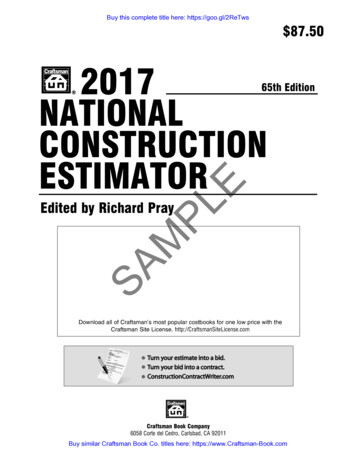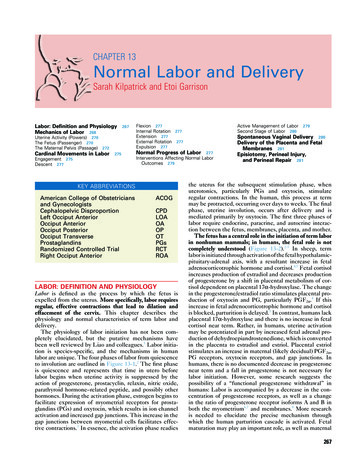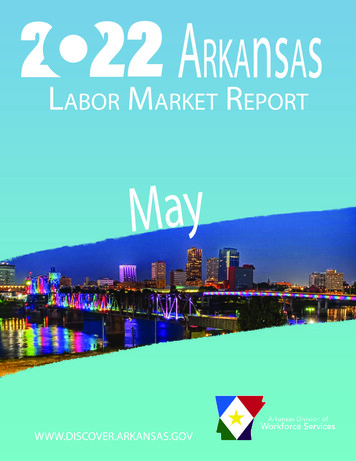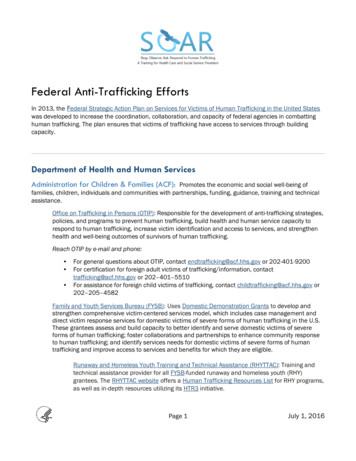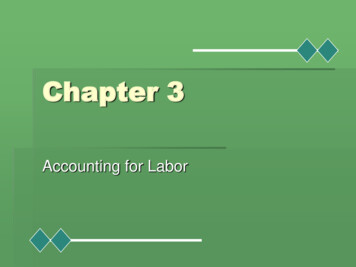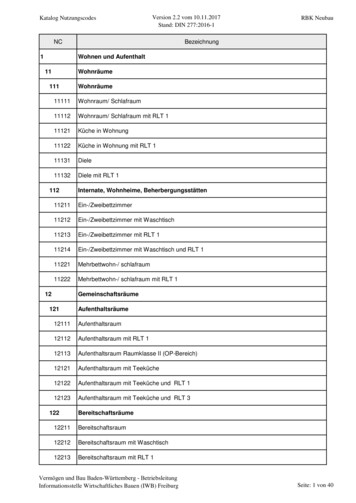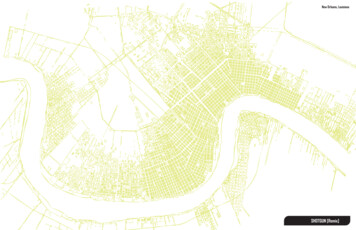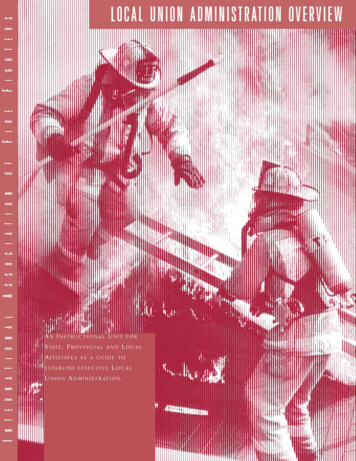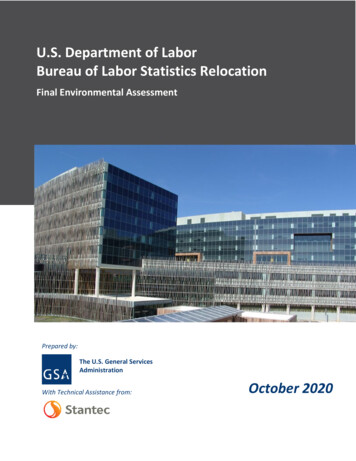
Transcription
U.S. Department of LaborBureau of Labor Statistics RelocationFinal Environmental AssessmentU.S. DPrepared by:DraftEnvironmentalThe U.S.General Services AssessmentAdministrationJuly 2020With Technical Assistance from:October 2020
This page is left intentionally blank.
BLS RelocationAbstractFinal Environmental AssessmentResponsible Agency:U.S. General Services AdministrationNational Capital Region1800 F Street, NWWashington, DC 20405U.S. Department of LaborBureau of Labor Statistics RelocationAbstractThe U.S. General Services Administration (GSA), National Capital Region, in cooperation with the U.S.Department of Labor, Bureau of Labor Statistics (BLS), has prepared this Environmental Assessment (EA) forthe relocation of BLS from the Postal Square Building, located at 2 Massachusetts Avenue, NE, Washington,DC, to the Suitland Federal Center (SFC), located at 4600 Silver Hill Road in Suitland, Maryland. GSA isproposing to relocate approximately 1,800 BLS employees to the SFC. The proposed BLS relocation projectwould upgrade existing building systems, renovate office space, and improve exterior land uses to supportthe co-location of three Federal agencies, namely BLS, the U.S. Bureau of Economic Analysis (BEA), and theU.S. Census Bureau (Census) within the SFC at the Suitland Federal Center Campus. The proposed action isintended to provide an efficient interior design that allows for approximately 367,000 rentable square feet(RSF) at the SFC for BLS.This EA has been prepared pursuant to the National Environmental Policy Act (NEPA) of 1969, as amended.Probable environmental impacts and potential mitigation measures have been identified for the actionalternative - relocation of the BLS to the SFC - and the No Action Alternative.Questions or written comments regarding the EA must be postmarked no later than October 8, 2020, andsent to the following address:U.S. General Services AdministrationNational Capital RegionAttention: Mr. Paul GyamfiOffice of Planning and Design Quality1800 F Street, Room 4400Washington, DC 20405Phone: (202) 440-3405Fax: (202) 708-5610Email: Paul.Gyamfi@gsa.govFinal Environmental Assessment – October 2020i
BLS RelocationAbstractThis page is left intentionally blank.Final Environmental Assessment – October 2020ii
BLS RelocationTable of ContentsTable of Contents1.0 Introduction . 1-11.1 What is GSA Proposing?. 1-11.2 What is the Purpose for Relocating the BLS? . 1-31.3 Why Does the BLS Need to be Relocated? . 1-31.4 Relevant Environmental Laws and Regulations. 1-3What is NEPA and the NEPA Process? . 1-3What is Section 106 of the National Historic Preservation Act? . 1-4What Other Environmental Laws and Regulations are Relevant to This Project? . 1-42.0 Alternatives Development . 2-12.1 How did GSA Determine Potential Sites for the Relocation of BLS, and Were Any Sites Dismissedfrom Further Consideration? . 2-12.2 Alternatives Considered . 2-1What is the No Action Alternative and Why is it Considered? . 2-1What Action Alternative Has GSA Evaluated in This Document? . 2-13.0 Affected Environment and Impacts to the Human Environment . 3-13.1 What is the Affected Environment and How Are the Impacts Evaluated?. 3-13.2 What Resource Issues Have Been Eliminated From Further Analysis? . 3-2Geology, Topography, and Soils . 3-3Groundwater Hydrology and Quality . 3-3Water Resources. 3-3Vegetation and Wildlife . 3-4Coastal Zone Management. 3-5Threatened, Endangered, and Sensitive Species. 3-5Visual Quality . 3-6Cultural Resources . 3-6Climate Change . 3-8Land Use Planning and Zoning. 3-8Noise . 3-9Population and Housing . 3-9Final Environmental Assessment – October 2020iii
BLS RelocationTable of ContentsEnvironmental Justice . 3-9Environmental Contamination . 3-103.3 What Resource Issues Have Been Included for Further Analysis? . 3-103.4 Economy and Employment . 3-11What is the Economic Make-up of the Community Surrounding the Proposed Site? . 3-11What Impact Would the Proposed Project Have on the Local and Regional Economy? . 3-12How Would the Proposed Project Affect Employment in the Area? . 3-13How Would the Proposed Project Affect Taxes and Revenue? . 3-14What Measures Would Be Taken to Reduce the Impact on the Local and RegionalEconomy? . 3-153.5 Community Facilities and Services . 3-15What Community Facilities and Services are Located Near the Suitland Federal CenterCampus?. 3-15How Would the Proposed Project Impact Community Facilities And Services?. 3-16What Measures would be Implemented to Reduce Adverse Impacts to CommunityFacilities and Services?. 3-173.6 Safety and Security . 3-17What Safety and Security Measures are Currently Provided at the Suitland Federal CenterCampus?. 3-17What Fire, Emergency Medical Services (EMS) and Police Facilities are Located Near thePostal Square Building and the SFCC? . 3-17What Impact Would the Proposed Project have on Safety and Security in the Area of theSFCC? . 3-21Will Police, Fire and EMS Stations that Serve the Property be Affected by the Proposed BLSRelocation? . 3-223.7 Traffic and Transportation . 3-23What Makes Up the Local Roadway Network?. 3-23How were Impacts to the Local Roadway Network Assessed?. 3-24How Would the Local Roadway Network be Affected by the BLS Relocation? . 3-24What Public Transportation Facilities and Services are Available in the Vicinity of theSuitland Federal Center Campus? . 3-28How Would Public Transportation Facilities and Services be Affected by the BLSRelocation? . 3-28How Would Pedestrians and Bicyclists Access the Suitland Federal Center Campus? . 3-29Final Environmental Assessment – October 2020iv
BLS RelocationTable of ContentsWhat Would be the Affect to Pedestrians and Bicyclists From the BLS Relocation? . 3-29What Measures Would be Taken to Reduce Impacts to the Transportation Network? . 3-303.8 Air Quality . 3-31Are There Any Air Quality Issues in the Washington Metropolitan Region? . 3-31Will the Proposed Project Impact Air Quality in the Area? . 3-32What Would be Done to Protect Air Quality During Construction?. 3-33What Permanent Measures Would be Taken to Reduce Long-Term Impacts to Air Quality?. 3-333.9 Utilities . 3-33Who Provides Utility Service to the Proposed Site?. 3-33How Would Utilities Be Impacted by the Proposed Project? . 3-34What Conservation Measures Would Be Incorporated into the Development of theProposed Site to Mitigate Impacts to Utilities and Increase Energy Efficiency?. 3-353.10 Waste Management . 3-35How Is Waste Be Managed at the Suitland Federal Center Campus?. 3-35How would the proposed project affect waste management?. 3-36What Conservation Measures Would Be Incorporated into the Development of theProposed Site to Mitigate Impacts to Utilities and Increase Energy Efficiency?. 3-363.11 What are Cumulative Effects and Why Are They Discussed? . 3-37What Past, Present, and Future Projects Could Add To or Interact With the Impacts of theProposed Project? . 3-37What Are the Cumulative Effects? . 3-373.12 Are There Any Adverse Environmental Effects Which Cannot be Avoided Associated with theProposed Project?. 3-393.13 What Relationships Exist Between the Local Short-Term Uses of the Proposed Project andMaintenance and Enhancement of Long-Term Productivity?. 3-403.14 Are There Any Irreversible and Irretrievable Commitments of Resources Associated with theProposed Project?. 3-403.15 What Are the Impacts From Each Alternative? . 3-403.16 What Mitigation Measures Would Be Implemented Under the Action Alternative? . 3-424.0 References . 4-15.0 List of Preparers . 5-16.0 Distribution List . 6-1Final Environmental Assessment – October 2020v
Table of ContentsBLS RelocationAppendix A – Scoping Letters and Comments .A-1Appendix B – Section 106 Consultation . B-1Appendix C –Agency Coordination . C-1Appendix D – Traffic Impact Study . D-1Appendix E – Transportation Management Plan . E-1Appendix F – Comments and Responses on the Draft EA . F-1List of FiguresFigure 1. BLS Existing and Proposed Locations. 1-2Figure 2. Statutes, Regulations, Plans, and Executive Orders . 1-5Figure 3. Location of the Suitland Federal Center Campus . 2-2Figure 4: SFC North and South Buildings Within the Suitland Federal Center Campus . 2-3Figure 5. Historic District and Resources at the Suitland Federal Center Campus. 3-7Figure 6. Community Facilities and Services Near the SFC. 3-16Figure 7. Metropolitan Police Department District 1 Police Service Areas . 3-18Figure 8. Prince George's County Police Department District 8 Beat Map . 3-20Figure 9. Overall Level of Service Conditions for the Action Alternative . 3-28List of TablesTable 1. Impact Intensity Thresholds . 3-1Table 2. Employment by Occupation . 3-11Table 3. Unemployment Rates 2016-2018 . 3-12Table 4. Crime Statistics by Category for the Area Around the Postal Square Building. 3-19Table 5. Crime Statistics by Grouping for the SFCC Area . 3-21Table 6. Future Auto Trip Generation . 3-25Table 7. Alternatives Lane Groups Operating at Overall LOS E or F and Overall Intersection LOS . 3-25Table 8. Comparison of Impacts . 3-41Final Environmental Assessment – October 2020vi
BLS RelocationAcronymsList of AcronymsACHPAdvisory Council on Historic PreservationACOEUnited States Army Corps of EngineersACSAmerican Community SurveyAADTAnnual Average Daily TrafficAEMSAdvanced Emergency Medical ServicesAMAnte MeridiemASTAboveground Storage TankBEABureau of Economic AnalysisBLSBureau of Labor StatisticsBMPBest Management PracticeCEQCouncil on Environmental QualityCFRCode of Federal RegulationsCOCarbon MonoxideCZMCoastal Zone ManagementCZMACoastal Zone Management Act of 1972DCDistrict of ColumbiaDHSU.S. Department of Homeland SecurityEAEnvironmental AssessmentECOS-IPaCEnvironmental Conservation Online System – Information for Planning and ConsultationEISEnvironmental Impact StatementEMSEmergency Medical ServicesEPAU.S. Environmental Protection AgencyESAEndangered Species ActFDAFood and Drug AdministrationFRFederal RegisterFEMAFederal Emergency Management AgencyFHWAFederal Highway AdministrationFOBFederal Office BuildingGHGGreenhouse GasGSAUnites States General Services AdministrationHCMHighway Capacity ManualFinal Environmental Assessment – October 2020vii
BLS RelocationAcronymsHVACHeating, Ventilation, & Air ConditioningIRSInternal Revenue ServiceLEDLight-Emitting DiodeLOSLevel of ServiceMDCMaryland Department of CommerceMDEMaryland Department of EnvironmentDHCDMaryland Department of Housing and Community DevelopmentMD DNRMaryland Department of Natural ResourcesMDOT SHAMaryland Department of Transportation State Highway AdministrationMHTMaryland Historical TrustM-NCPPCMaryland-National Capital Park and Planning CommissionMOUMemorandum of UnderstandingMPDMetropolitan Police DepartmentMSAMetropolitan Statistical AreaMSATMobile Source Air ToxicsMWCOGMetropolitan Washington Council of GovernmentsNAAQSNational Ambient Air Quality StandardsNASANational Aeronautics and Space AdministrationNEPANational Environmental Policy ActNHPANational Historic Preservation ActNMICNational Maritime Intelligence CenterNO2Nitrogen DioxideNOAANational Oceanographic and Atmospheric AdministrationNRHPNational Register of Historic PlacesO3OzonePbLeadPBSPublic Buildings ServicePEPCOPotomac Electric Power CompanyPM2.5Fine Particulate Matter (particles with a diameter of 2.5 micrometers and smaller)PM10Particulate Matter (particles with a diameter of 10 micrometers or less)PSAPolice Service AreaRCRAResource Conservation and Recovery ActRSFRentable square footageFinal Environmental Assessment – October 2020viii
BLS RelocationAcronymsSfSquare FootageSFCSuitland Federal CenterSFCCSuitland Federal Center CampusSHPOState Historic Preservation OfficeSIPState Implementation PlanSO2Sulfur DioxideSPCCSpill Prevention Control & CountermeasureU.S.United StatesU.S.C.United States CodeUSDAUnited States Department of AgricultureUSFWSUnited States Fish and Wildlife ServiceUSTUnderground Storage Tankv/cVolume to CapacityWMATAWashington Metropolitan Area Transit AuthorityWSSCWashington Suburban Sanitary CommissionFinal Environmental Assessment – October 2020ix
BLS RelocationAcronymsThis page left intentionally blank.Final Environmental Assessment – October 2020x
BLS RelocationIntroduction11.0 IntroductionThe U.S. General Services Administration (GSA) has prepared this Environmental Assessment (EA) to assessand report potential impacts resulting from the relocation of approximately 1,800 employees of the U.S.Department of Labor’s Bureau of Labor Statistics (BLS) from leased space in Washington, DC, to the SuitlandFederal Center (SFC) in Suitland, MD.The National Environmental Policy Act (NEPA) requires Federal agencies to prepare an EA to determine if anaction has the potential to significantly affect the quality of the human environment. GSA has prepared thisanalysis in cooperation with BLS to disclose to the public the potential environmental impacts that therelocation of BLS employees to the SFC may have on the human environment, including impacts to theeconomy and employment, community facilities and services, safety and security, traffic and transportation,air quality, utilities, and waste management.In addition, GSA is integrating the Section 106 consultation process, as required by the National HistoricPreservation Act (NHPA), with the NEPA process. GSA is using this EA to provide information regardingpotential adverse effects to historic resources that may result from the proposed lease consolidation.The public is encouraged to review this document tolearn more about the proposed BLS relocation and itspotential impacts. The public is also encouraged toprovide comments on the EA.Written comments on the EA may be sent to:U.S. General Services AdministrationNational Capital RegionMr. Paul GyamfiOffice of Planning and Design Quality1800 F Street, NW, Room 4400Washington, DC 20405paul.gyamfi@gsa.govCOOPERATING AGENCIESCooperating agencies, as defined by 40 CFR§§1501.6 and 1508.5, are Federal agenciesother than the lead agency which havejurisdiction by law or special expertise withrespect to any environmental impact underthe proposed action. BLS is acting as acooperating agency for this EA. BLS’ role as acooperating agency is to participate in theNEPA process, provide information andenvironmental reviews, and make staffavailable to support the NEPA process at itsown expense.1.1 What is GSA Proposing?GSA is proposing to relocate approximately 1,800 BLS employees from the Postal Square Building at 2Massachusetts Avenue, NE, Washington, DC, to the SFC in Suitland, Maryland (Figure 1). The proposed BLSrelocation project would upgrade existing building systems, renovate office space, and improve exterior landuses to support the co-location of three Federal agencies, namely BLS, the U.S. Bureau of Economic Analysis(BEA), and the U.S. Census Bureau (Census) within the SFC. The proposed action is intended to provide anefficient interior design that allows for approximately 367,000 rentable square feet (RSF) at the SFC for BLS.Final Environmental Assessment – October 20201-1
1IntroductionBLS RelocationFigure 1. BLS Existing and Proposed LocationsFinal Environmental Assessment – October 20201-2
BLS Relocation1Introduction1.2 What is the Purpose for Relocating the BLS?The purpose of the proposed action is to relocate BLS to the Suitland Federal Center Campus (SFCC). Theproposed investment in, and space optimization of, the North and South buildings at the SFC will facilitatethe achievement of more efficient utilization rates for all three Federal organizations, and reduce rentalpayments made by BLS, Census, and BEA.1.3 Why Does the BLS Need to be Relocated?The relocation of BLS is needed to meet the requirements set forth in the U.S. Office of Management andBudget (OMB) Memorandum M-12-12, which requires the Federal Government to reduce its overallfootprint and look at Federal space first before seeking out other leases.1.4 Relevant Environmental Laws and RegulationsWhat is NEPA and the NEPA Process?NEPA is the nation’s legislative charter for protection of the environment. NEPA requires Federal agencies toconsider environmental impacts of their actions during planning and decision-making. Federal agencies mustprepare an EA if the significance of the impacts that may result from the proposed action is unknown. GSA’sEAs and other NEPA documents are prepared in accordance with the Council on Environmental Quality(CEQ) regulations for implementing NEPA (40 Code of Federal Regulations CFR Parts 1500-1508), GSA OrderADM 1095.1F – Environmental Considerations in Decision Making, and the Public Buildings Service (PBS)NEPA Desk Guide (October 1999).Public involvement is an important part of the NEPA process. Title 40 CFR Part 1500.1(b) states, in pertinentpart, “NEPA procedures must ensure that environmental information is available to public officials andcitizens before decisions are made and before actions are taken.” Byinvolving citizens, stakeholder groups, and local, state,and Federal agencies, GSA can make better informedNEPA PUBLIC INVOLVEMENT PROCESSdecisions.Scoping“Scoping” is a tool to be used at the beginning of theMarch 2020NEPA process for identifying the issues that should bePublication of Final EAaddressed in the EA and Section 106 processes.October 2020Scoping allows the public to help define priorities andexpress stakeholder and community issues to theDecision Documentagency through written comments. GSA initiated theOctober 2020public involvement processes through the distributionof scoping letters to local, state, and Federal agencies,elected officials, and other interested parties. The scoping period for the proposed action was open fromFebruary 23, 2020 through March 23, 2020. GSA received six comments during the scoping period. The keyissues identified during scoping included the following:Final Environmental Assessment – October 20201-3
1Introduction BLS RelocationCommunity FacilitiesIncreased trafficIncrease/change in commuteParkingAdditional recreational facilitiesComments received during the scoping period were considered during the development of the EA(Appendix A). Through the NEPA process, the public has had and will continue to have opportunities tocomment on the BLS relocation.What is Section 106 of the National Historic Preservation Act?The NHPA governs Federal agencies in their handling ofhistoric properties. Section 106 of the NHPA requiresThe National Register of Historic Places isFederal agencies to consider the effects of theirthe nation's official list of cultural resourcesundertakings on historic properties and afford the Advisoryworthy of preservation. Properties listed inCouncil on Historic Preservation (ACHP), as well asthe register include districts, sites, buildings,interested consulting parties, a reasonable opportunity tostructures, and objects that are significant inAmerican history, architecture, archaeology,comment. Under the historic preservation review processengineering, and culture.mandated by Section 106 as outlined in regulations issuedby the ACHP (36 CFR Part 800), GSA must evaluate theundertaking to determine if it is a type of activity that couldaffect historic properties, which are defined as any district, site, building, structure, or object listed in oreligible for listing in the National Register of Historic Places (NRHP).Section 106 review encourages the preservation of historic properties; however, at times, impacts tohistoric resources cannot be avoided. When the Federal Government must impact cultural resources, it isrequired to consult with local, state, and Federal agencies responsible for historic preservation, localcitizens, and groups with an interest in historic preservation. In a letter dated March 20, 2020, the MarylandHistorical Trust (MHT) concurred with GSA’s finding of no adverse effect for this project. Additionally, GSAinitiated consultation with the Delaware Nation and the Delaware Tribe of Indians. No responses have beenreceived from either of these tribes. Please see Appendix B for all Section 106 correspondence. Additionalinformation on GSA’s consultation under Section 106 can be found in Section 3.2.8, Cultural Resources. Thepublic is encouraged to comment on historic preservation issues during the public review period of this FinalEA (June 30, 2020 – July 30, 2020).What Other Environmental Laws and Regulations are Relevant to This Project?As a Federal agency, GSA must comply with all applicable laws and regulations. GSA is incorporatingcompliance with these laws and regulations into its project planning and NEPA compliance. Figure 2 providesa list of potentially applicable laws and regulations.Final Environmental Assessment – October 20201-4
BLS RelocationIntroduction1StatutesClean Air Act of 1970 as amended (42 U.S.C. § 7401, et seq.)Clean Water Act of 1977 as amended (33 U.S.C. § 1251, et seq.)Comprehensive Environmental Response, Compensation and Liability Act of 1980 (42 U.S.C. § 9601, et seq.)Archaeological Resources Protection Act of 1979 (16 U.S.C. § 470aa-mm)Endangered Species Act of 1973 (16 U.S.C. § 1531-1544)Section 5 of the National Capital Planning Act of 1952 (82 P.L. 592; 66 Stat. 781, et seq.); (codified as amended at 40 U.S.C. §8722(b)(1))Resource Conservation and Recovery Act of 1976 (42 U.S.C. § 6901, et seq.)National Energy Conservation Policy Act (42 U.S.C. § 8231, et seq.)Energy Independence and Security Act (42 U.S.C. § 17001, et seq.)National Historic Preservation Act of 1966 (16 U.S.C. § 470, et seq.) (89 P.L. 665 (1966)); (referred to herein as “Section106”)Coastal Zone Management Act of 1972 (16 U.S.C. Chapter33 § 1451, et seq.)RegulationsCouncil on Environmental Quality Regulations (40 Code of Federal Regulations [CFR] Parts 1500-1508)36 CFR 800 – Protection of Historic Properties32 CFR 229 – Protection of Archaeological Resources: Uniform Regulations40 CFR 6, 51, and 93 – Conformity of General Federal Actions to State or Federal Implementation Plans33 CFR 320-330 – U.S. Army Corp
BLS Relocation Abstract Final Environmental Assessment - October 2020 i Final Environmental Assessment. Responsible Agency: U.S. General Services Administration . National Capital Region . 1800 F Street, NW . Washington, DC 2040 5 . U.S. Department of Labor . Bureau of Labor Statistics Relocation . Abstract
